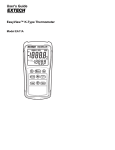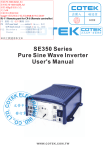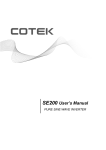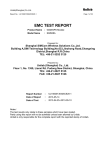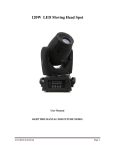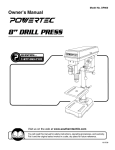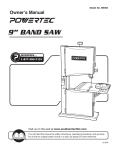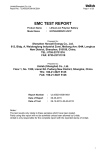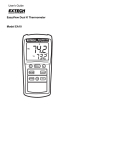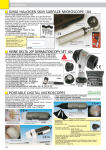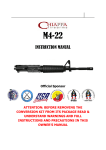Download IMMERSION PROBE
Transcript
IMMERSION PROBE USER MANUAL Nr. 135 EDITION 05/99 rev. 0 TABLE OF CONTENTS Par. 1.0 Pag. AN OUTLINE ON WATER DISINFECTION .................................................... WARRANTY CONDITIONS ................................................................................................ 3 1.0 AN OUTLINE OF THE APPARATUS ............................................................. 4 1.1 Applications..................................................................................................... 4 1.2 Measurement types ........................................................................................ 4 2.0 DESCRIPTION ............................................................................................... 4 2.1 Full measurement system............................................................................... 4 2.2 Realization ...................................................................................................... 5 3.0 TECHNICAL CHARACTERISTICS ................................................................ 5 4.0 DIMENSIONS ................................................................................................ 5 5.0 SET UP ........................................................................................................... 6 6.0 ELECTRICAL CONNECTIONS ...................................................................... 6 7.0 STARTING...................................................................................................... 6 8.0 CALIBRATION ................................................................................................ 6 8.1 pH measurement system calibration .............................................................. 7 8.2 ORP measurement system calibration .......................................................... 7 8.3 Dissolved oxygen measurement system calibration ...................................... 8 8.4 ISE measurement system calibration ............................................................. 8 8.5 Conductivity measurement system calibration ............................................... 9 9.0 USE AND MAINTENANCE............................................................................. 9 10.0 ELECTRODES REPLACEMENT ................................................................... 9 11.0 SPARE PARTS............................................................................................. 10 11.1 Information for full SI/32 probe order ............................................................ 12 12.0 RETURN FOR REPAIR................................................................................ 12 12.1 Procedures under the care of customer ....................................................... 12 12.2 Repair procedure .......................................................................................... 12 REPAIR – REVISION – CALIBRATION SHEET ......................................... 15 2 As the first thing, thank you for your choice. Our products are manufactured according to ISO 9001 procedures to assure maximum reliablity in any application, even in worst conditions. WARRANTY CONDITIONS All our products, after manufacturing process, are subject to restrictive tests and are warranted for 12 months from purchase date. Should any component fail during warranty period, our Company will repair or replace at no charge, after having verified cause of failure. Warranty doe not include complete instrument replacement and our Company will reject any request of indemnity for damages. Repair on warranty is intended at our Service Department (ex-works): transport expenses are on customer charge. The customer is kindly requested to send the REPAIR – REVISION – CALIBRATION SHEET fully filled in together with the instrument and to retain the original invoice or packing list as a purchase evidence. Warranty does not include: accidental ruptures during transport, failures due to uncorrect use, to negligence, to wrong power supply connection, all the consumable and weary parts and all accessories. Warranty does not cover products that have been tampered with or repaired by non authorized personne. Warranty does not cover requests for service. Any disputes arising shall be settled in the Court of Milan under Italian law and commercial customs. 1.0 AN OUTLINE OF THE APPARATUS 1.1 Applications The SI/32 immersion electrodes holder probe, is built to house one of the following measurement electrodes: pH, redox, ISE, conductivity, dissolved oxygen and temperature and to allow direct insertion in basin, tanks or canals. The extremely strong and compact built guarantees electrodes protection even in serious applications. The probe has a sliding flange that simplifies mounting on wall, or on tub rim. The 300 mm version of the SI/32 can be set up on a floating. 1.2 Measurement types The SI/32 probe can host one electrode for pH, redox, ISE, conductivity, dissolved oxygen and temperature measurements. Electrodes that can be installed are: 3 MEASURE DESCRIPTION Mod. pH Combined electrode 101/V o 101/GEL Redox Combined electrode 201/V (Pt o Au) o 201/GEL (Pt o Au) Conductivity Conductivity sensor 401/L –K1 D.O. Dissolved oxygen sensor 332/P Temp. Temperature sensor Pt100 PtL On demand we can install, beyond pH, DO or conductivity electrode, a temperature sensor, fixed in the ring nut electrodes holder. 2.0 DESCRIPTION 2.1 Full measurement system The full measurement system is composed by the measurement electrode inserted in the sensor holder probe, by the temperature sensor if required (inserted in the electrode holder ring nut), by the possible branch box and by the electronic unit related to the parameter to measure. Fig.1 2.2 FULL MEASUREMENT SYSTEM Realization The SI/32 probe is made of a PVC cylindrical body (PP, PVDF or INOX on demand), ∅ 32 mm and a standard length of 600 mm (800 mm, 1000 mm, 1500 mm on demand); the 300 mm version for set up on a floating is available on demand. In the lower part of the body is screwed a waterproof sensor holder rest, in which can be inserted one of the electrodes described in 1.2. O-rings guarantee the electrode seal. The electrodes holder rest is threaded in the lower part and here the electrodes protection ring nut is screwed. The DN25 sliding flange can be positioned along all the probe body. To stop tighten the two socket head screws. On the superior part of the probe is mounted a closure cap, while the connection wire to the transmitter exit by means of a waterproof fairlead on the superior part of the probe body. 3.0 TECHNICAL CHARACTERISTICS Electrodes number: 1 (on demand temperature sensor inserted in electrode holder ring nut ) 4 Body material: PVC, (PP, PVDF or INOX on demand) Dimensions: ∅ 32, under flange standard length standard 600 mm (800mm, 1000 mm, 1500 mm, o demand); also available the 300 mm version for floating set up Wires outlet Max working temperature: (considering the electrodes max temperature) fairlead on probe’s superior side PVC 60 °C PP 70 °C PVDF 90 °C INOX 120 °C Max stocking temperature: 0÷60 °C Max pressure: depending on the electrode type inserted Dip depth: depending on probe length; min immersion depth 100 mm Fixing sliding flange: DN25 Weight: about 0,4 kg for the 600 mm version Max distance from the electronic unit: 50 m (stopped wires) 4.0 DIMENSIONS Fig.2 SI/32 IMMERSION PROBE OVERALL DIMENSIONS 5 5.0 SET UP CAUTION: The measurement and reference electrodes mounted in the probe are provided with protection cap. Remember to remove before use. Fig.3 shows an example of typical set up of the SI/32 immersion probe and an example of floating probe set up. Place the probe in the process vertically by means of the rest flange DN”% (see fig.3) and properly ad just immersion depth using the two inox screws sideways to the flange (min immersion depth 100 mm); make always sure that process liquid is moved and stirred and that the probe is set up in a representative position. It is now necessary to realize electrical connections. Fig.3 SI/32 PROBE TYPICAL SET UP 6.0 ELECTRICAL CONNECTIONS Sensor is supplied complete with its wire. Realize connection in the electronic unit following instructions in the specific user manual. CAUTION! 7.0 Connection wires to the electronic unit must be steady set up and don’t have to pass together with other cables. This eliminates troubles and interferences and allows to set up the probe to a distance up to 50 m from the electronic unit. STARTING Once the probe is set up and connections to the electronic unit are realized, let operate the measurement chain for half on hour to let the reading stabilize, then proceed with calibration. 8.0 CALIBRATION After conditioning period (1/2 hour) calibration can start. Following procedure mainly refer to sensors, the correct procedure to follow in calibrating electronics depends on the electronic unit type used and can be found in the specific user manual. 6 8.1 pH measurement system calibration pH measurement chain, is composed by a measurement electrode and by a reference electrode; voltage produced by such a chain depends on different factors: the measurement electrode potential, the reference electrode potential, the glass membrane potential, the potential due to the solution pH value. So, even if the pH equality in the sample solution, potential produced will be slightly different for each measurement chain; calibration realize the standardization of those little differences. The pH chain calibration is made by means of buffered solutions. Procedure to apply depends on the type of electronic unit connected (calibration with potentiometer or with keyboard and display). For further details refer to user manuals of different electronic unit. We suggest to use the specific calibration glass (request to your provider, Mod.32-TAR). CAUTION Never dry the electrode rubbing it with rags, paper or other materials: electrodes have an high ohmic resistance and rubbing the glass membrane produces a strong polarization of the electrode reducing in this way up to 90% its answering speed to pH variations. If so, before any calibration wait for 10-15 min by leaving electrode plunged in water or in the buffered solution. Unscrew and remove the electrodes protection. Clean electrodes before proceeding. In the clean beaker, pour a quantity of a pH 7.0 buffered solution enough to wet the electrodes; hold the probe vertically and tighten the beaker. Allow that reading stabilizes, then do zero calibration in the electronic. Then remove the beaker, throw the pH 7.0 buffered solution and rinse; pour the pH 4.0 buffered solution (or other solutions) till the right level, rinse the electrode and screw the beaker. Allow the reading stabilizes then calibrate slope on the electronic (according to the pH of the buffered solution used). Remove the beaker , restore electrodes protection, then reinstall the probe in the process. Now the analyzer can be set at work. 8.2 ORP measurement system calibration The redox potential measurement chain is composed by a metallic (usually Gold and Platinum) measurement electrode and by a reference electrode. Redox potential measurement doesn’t require any calibration for operating. Potential provided by the electrodes chain is the addition of the constant reference electrode potential and by the sample liquid redox potential. The resultant of those potentials could not be in the measurement range of the instrument. For this reason ORP measurement electronics are equipped with an asymmetry command that allows to algebraically add, to the potential provided by the electrodes chain, a potential that brings back the measurement in the transmitter scale. To realize this it is necessary to follow those steps : Wash the probe’s edge with water and plunge it into the sample fluid. This must already have a pH value suitable to the reaction we want to realize). Wait for some minutes until measurement stabilizes. (If transmitter’s indicator moves beyond full scale verify if connections are correct). Operate on the potentiometer or on the zero calibration point until the zero value is showed on the electronic. Now the analyzer can be set at work. From this moment readings will indicate redox potential variations in the sample liquid compared to the zero point preset. Consider that redox potential measurement depends on all oxidants and reducents in the solution, and not only to a specific ion. Therefore it is necessary to repeat calibration when and if the composition of the sample solution changes in time. On the contrary, if solution keep constant its characteristics, calibration is not necessary. 7 8.3 Dissolved oxygen measurement system calibration Zero point in dissolved oxygen analyzer is usually factory set and so doesn’t require further calibrations. The recommended calibration procedure for this analyzers is the following: -expose oxygen sensor to air, keeping possibly in the shade. -wait until sensor’s signal stabilizes -measure the room temperature of the position where the probe is located and get from the following chart the ppm oxygen value to calibrate -correct slope on the electronics on the basis of the value read on the chart. CHART 1 OXYGEN PPM VALUES TO USE FOR AIR CALIBRATION, DEPENDING ON ALTITUDE AND TEMPERATURE °C 775 mmHg 760 mmHg L.M. 750 mmHg 120 m 725 mmHg 365 m 700 mmHg 610 m 675 mmHg 850 m 0 2 4 6 8 10 12 14 16 18 20 22 24 26 28 30 32 34 36 38 40 42 44 46 48 50 14.9 14.1 13.4 12.7 12.1 11.6 11.1 10.6 10.1 9.7 9.3 9.0 8.7 8.4 8.1 7.8 7.6 7.3 7.1 6.9 6.7 6.5 6.3 6.1 5.9 5.7 14.6 13.9 13.2 12.5 11.9 11.3 10.8 10.4 9.9 9.5 9.2 8.8 8.5 8.2 7.9 7.7 7.4 7.2 7.0 6.7 6.5 6.3 6.1 5.9 5.8 5.6 14.4 13.7 13.0 12.3 11.7 11.2 10.7 10.2 9.8 9.4 9.1 8.7 8.4 8.1 7.8 7.6 7.3 7.1 6.9 6.6 6.4 6.2 6.0 5.9 5.7 5.5 13.9 13.2 12.5 11.9 11.3 10.8 10.3 9.9 9.5 9.1 8.7 8.4 8.1 7.8 7.6 7.3 7.0 6.8 6.6 6.4 6.2 6.0 5.8 5.6 5.5 5.3 13.5 12.9 12.1 11.5 10.9 10.4 10.0 9.5 9.1 8.8 8.4 8.1 7.8 7.6 7.3 7.0 6.8 6.6 6.4 6.2 6.0 5.8 5.6 5.4 5.3 5.1 12.9 12.3 11.7 11.1 10.5 10.1 9.6 9.2 8.8 8.4 8.1 7.8 7.5 7.3 7.0 6.8 6.6 6.3 6.1 5.9 5.7 5.6 5.4 5.2 5.0 4.9 As a rule, zero point doesn’t require calibration. It is however possible to verify calibration as follows: fill a container big enough to contain the probe’s trailing, with distilled or light water, melt in approx 1g/l of sodium sulfite (a reducent that eliminates all oxygen from the solution) Allow the sensor stabilization and zero calibrate, if necessary. Now the analyzer can be set at work. 8.4 ISE measurement system calibration In calibrating selective ions analyzers, we recommend to carefully follow instructions supplied with each ISE sensor. This because they are so different each other in shape, slope and in use. 8 8.5 Conductivity measurement system calibration For conductivity measurement system calibration, it is necessary to acquire at least one standard solution with known conductivity value ( the solution type is related to the full scale of the analyzer). Then proceed as follows: - Unscrew the electrodes protection from the probe, rinse and drip the electrode, fill to the correct level calibration beaker and insert the electrode - Wait for some minutes until reading stabilizes and verify if reading of the electronic matches with standard solution value. If necessary correct slope working on electronic unit. Restore electrodes protection, then reinstall the probe. Now the analyzer can be set at work. 9.0 USE AND MAINTENANCE We recommend to regularly clean sensor: Frequency depends on the process type and will be established on a direct experience basis. We also recommend, after cleaning the sensor, to regularly – depending on direct experience - verify the measurement and if necessary recalibrate it (to verify the measurement proceed either with a portable measurer opportunely calibrated, or plunging the probe into a solution with a known concentration of the measurement parameter and verifying that reading matches with such value). To diminish cleaning operation frequency, it is possible to acquire by your provider, the chemical cleaning kit, Mod.SI/CH-AP and the board to control cleaning sequence (Mod.QAPCH). 10.0 ELECTRODES REPLACEMENT Refer to fig. 4 “SI/32 Assembling scheme” for a better comprehension of the following description. 1. 2. 3. 4. 5. 6. Unscrew the electrode holder (7) from the probe’s body (9) making sure not to twist cables. Take out the electrode holder joint sliding cable through probe’s body. Extract the electrode to substitute from electrodes holder joint pulling up. We recommend to substitute the specific O-Ring (6), when the electrode is replaced Replace the broken electrode and position it to obtain the correct projection Reassemble the probe and close it again executing the above instructions in opposite direction Note: If the shielded cable of the measurement electrode has to be restored (for pH, redox and ISE), ensure that the black semi conductive sheath located between the shielding and the internal wire polyethylene protection is removed for at least 20 mm. 9 11.0 SPARE PARTS Refer to Fig.4 “SI/32 assembling scheme” and to the following chart. Remember to mention, in the possible order, model and serial number of your product, as well as the spare part code of the required component. Fig.4 SI/32 ASSEMBLING SCHEME 10 SI/32 SPARE PARTS Pos.in Fig.4 1 1 1 1 2 3 3 3 3 4 4 4 4 4 4 4 5 5 5 5 6 + 11 7 7 7 7 7 7 7 7 8 8 8 8 9 9 9 9 10 10 10 10 Spare code S32-001 S32-002 S32-003 S32-004 S32-005 S32-006 S32-007 S32-008 S32-009 101/N 101/N-DG-SM 201/N (Pt O Au) 201/N (Pt O Au) 401/L-K1 332/P Pt/L S32-010 S32-011 S32-012 S32-013 S32-014 S32-015 S32-016 S32-017 S32-018 S32-019 S32-020 S32-021 S32-022 S32-023 S32-024 S32-025 S32-026 S32-027 S32-028 S32-029 S32-030 S32-031 S32-032 S32-033 S32-034 S32-035 Description CAP CAP CAP CAP RUBBER FAIRLEAD 34.21.230 BODY BODY BODY BODY pH ELECTRODE pH ELECTRODE REDOX ELECTRODE REDOX ELECTRODE CONDUCTIVITY ELECTRODE DISSOLVED OXYGEN ELECTRODE TEMPERATURE SENSOR O-R PUSHER O-R PUSHER O-R PUSHER O-R PUSHER OR SPARE KIT It contains: n°1OR 115 11.91x2.62x17.15 (Pos.6) n°3 OR2100 25.12x1.78x28.68 (Pos.11) NIPPLE WITH THERMORESISTANCE for SI/32…C NIPPLE WITH THERMORESISTANCE for SI/32…C NIPPLE WITH THERMORESISTANCE for SI/32…C NIPPLE WITH THERMORESISTANCE for SI/32…C NIPPLE WITHOUT THERMORESISTANCE for SI/32 NIPPLE WITHOUT THERMORESISTANCE for SI/32 NIPPLE WITHOUT THERMORESISTANCE for SI/32 NIPPLE WITHOUT THERMORESISTANCE for SI/32 PROTECTION PROTECTION PROTECTION PROTECTION PROBE EXTENSION PROBE EXTENSION PROBE EXTENSION PROBE EXTENSION NIPPLE FOR PROBE EXTENSION NIPPLE FOR PROBE EXTENSION NIPPLE FOR PROBE EXTENSION NIPPLE FOR PROBE EXTENSION DN25 PROBE SUPPORT FLANGE Material PVC PP PVDF INOX PVC PP PVDF INOX PVC PP PVDF INOX PVC PP PVDF INOX PVC PP PVDF INOX PVC PP PVDF INOX PVC PP PVDF INOX PVC PP PVDF INOX Q.ty 1 1 1 1 1 1 1 1 1 1 1 1 1 1 1 1 1 1 1 1 1+ 3 1 1 1 1 1 1 1 1 1 1 1 1 1 1 1 1 1 1 1 1 1 With your supplier you can find solutions with fixed value for pH, redox, conductivity calibration. Mod. ! - ! T/101– Buffered solution value Bottles 1 4 7 Mod. T/401– ! A B C 250 cc 500 cc 1000 cc Specify desired conductivity value: 1 mS, 12 mS, 100 mS. 11 11.1 Information for full SI/32 probe order SI/32 - ! - ! Material PVC 1 PP 2 PVDF 3 INOX 4 Length 1 = 600 mm 2 = 800 mm 3 = 1000 mm 4 = from 1000 to 1500 mm on demand 12.0 RETURN FOR REPAIR Should any equipment misfunctioning appear, pls contact our Technical Department. Should the equipment be broken or faulty pls proceed to return for rapair as described hereafter. 12.1 Procedures under the care of customer Fill in each part the enclosed REPAIR – REVISION – CALIBRATION sheet Attach the form to the equipment and ship them to: The material will be sent ex warehouse. To avoid unpleasant trouble, we inform the Customers that carriage forward shipping will not be accepted. 12.2 Repair procedure When the material with the form REPAIR – REVISION – CALIBRATION will be received, we will send, as soon as possible, an estimated cost, before proceeding to any intervention on the equipment. To each equipment received for repair or revision we assign a number that will be used as the reference for all the techniacl and commercial information. No intervention will be carried out on the equipment without previous customer written approval. Should the the repair cost estimate require some work, a minimum of 150.000 Itl. will be invoiced, even if the customer does not confirm the approval to repair. Repairs under warranty won’t be invoiced, except for freight cost, that will always be charged to customer. Should any information be required, pls, contact our technical and commercial department. 12 REPAIR – REVISION - CALIBRATION Company__________________________________ Address___________________________________ Mod.N.________________________ Serial N.________________________ Town___________________Nation___________ Tel._____________________Fax_______________ Purchase date____________________ Type of operation Repair Revision Calibration Detected fault As the good has been received During calibration procedure At start up Intermittent After apprx. Steady - Detected fault:___________________________________________________________________ _____________________________________________________________________________________ _____________________________________________________________________________________ _____________________________________________________________________________________ _____________________________________________________________________________________ _____________________________________________________________________________________ Riservato al costruttore Date________________ Rip. n°_________________ Invoice n°_________________ dated___________ Cost estimate n°_________________ of___________ ________ Lit.___________________________ Remarks:__________________________________________________________________________ _____________________________________________________________________________________ _____________________________________________________________________________________ _____________________________________________________________________________________ Equipment return - Customer carrier Name___________________________________ Tel.________________ Address_______________________________________________________________________________ - Our carrier with 25.000 Itl charge on invoice (up to 0.3 kg) and 30.000 Itl. charge (up to 20 kg) + VAT NOTE: if written approval for reapair is not received within 40 days, the goods will be returned with our carrier with a charge of 200.000 Itl on invoice. 13 14














